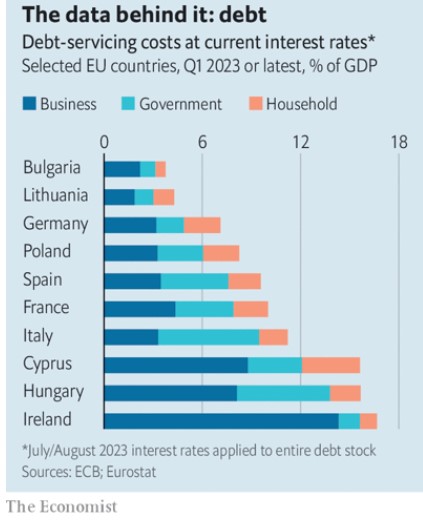Europe must face the 5 crucial challenges, knowing that within the EU the member countries are different, with non-homogeneous weaknesses and strengths. For this reason, victory is not easy.

Europe is going through a very complex period, with at least 5 crucial challenges for the near future to face - and overcome - in order to survive in a world undergoing sudden, and sometimes dangerous, changes.
The EU is burdened by its institutional structure: a set of 27 countries united by common intentions, but in fact heterogeneous in their economic potential and weaknesses. With the awareness, however, that everything is changing and that nationalism (i.e. protectionism of particular interests) of individual members alone is not sufficient.
From the energy sector to security, to the disruptive importance of geopolitics, to the green transition, the inflationary crisis, and demographic depression, Europe appears besieged.
With Germany in recession and slowing growth throughout the common currency states, while the ECB remains firm in its intent to bring inflation back to 2% with high rates, the old continent seems to be in decline. Meanwhile, in the background, the war in Ukraine, the conflict in Israel, and the migrant crisis are raging.
In summary, the EU is called to overcome at least 5 challenges in order to establish itself as a global protagonist. In each of them, however, European states present different conditions for dealing with them. An interesting analysis by The Economist highlighted these differences and their weight in European economic prospects.
1. Inflation
The first significant challenge for Europe is undoubtedly the decline in inflation, reaching the ECB’s 2% target sooner rather than later. The European Central Bank has dramatically increased interest rates to achieve this goal.
The interesting observation concerns the different levels of consumer prices recorded by the Eurozone countries, showing how Frankfurt’s aggressive policy can lead to non-homogeneous results.
For example, in Austria, annual inflation is still at 5.8%, while in Greece it has fallen to 2.4%, close to the 2% target. The same interest rate could therefore soon become too low for some and too high for others.
Ideally, inflation in all EU countries should be close to the eurozone average, even in those that do not use the common currency. Those whose inflation rate deviates too much from the eurozone average (currently at 4.3%), whether below or above it, will likely face a rather complicated period of adjustment.
2. Debt
The debt challenge is one of the most insidious. Higher interest rates will hit countries that already have high public or private debt hardest.
Again, differences abound. Tax havens such as Ireland, Cyprus, or Luxembourg have high corporate debt without this having much impact on the local economy.
But in Hungary, the Scandinavian countries, and the Netherlands, private debt service could represent a brake on consumption, construction, and investments. In the Netherlands, the decline in household pension assets in recent years will only exacerbate the problem.
In Italy and Greece, it will be the governments who will soon have to set aside more funds for debt service. A graph developed by Economist on Eurostat data can help to understand how the starting point of some countries is different and how much the percentage weight of all debt on GDP differs:

Economist analysts calculated debt servicing costs, as a share of GDP, on the total stock of debt of businesses, households, and governments as if the rates currently charged on new loans or bonds were applied to the entire stock of debt. It emerged that each State has its own peculiar debt composition, resulting in a greater or lesser weight of such high rates.
3. Decarbonization of the economy
A very delicate topic on which the EU is focusing a lot is that of decarbonization of the economy.
Greening transport and heating will require huge investment and should actually stimulate growth in the short term, with households and governments taking on debt to finance the new course. Investments in renewable energy production will have a similar effect.
Decarbonizing the industry, however, will be more difficult, as companies face competition at home and abroad. Until green electricity becomes abundant and cheap, its costs will remain higher. This is also true in countries that have nuclear energy or a lot of renewable energy: as European energy markets are increasingly connected, prices tend to move together.
The issue to observe according to experts is the fact that the overall consumption of gas and electricity by industry differs widely across Europe in terms of percentage of GDP. Within the group of rich countries, Finland and Belgium stand out as large industrial energy consumers. Spain and Germany also fall into the high-energy group, while Poland and France are lower in this discipline.
4. Demographic crisis
Of close relevance, especially in Europe, is the fight against aging and low birth rates on the continent. The so-called demographic crisis, in fact, has various repercussions on the economy.
In the past, successful countries have stabilized their birth rates, imported immigrants to enrich their economies, encouraged workers to stay at work into their 60s, and persuaded men to do their share of care work at home so that women could also have a profession.
The situation is not so today and European members differ in the composition of the working-age population.
The Economist calculated a net contraction in the available workforce, without migration, by doing this: the number of people aged 60 to 64, who are close to retirement, minus young people aged 15 and 19 years old, who will soon enter the job market.
The balance is negative for central and eastern European countries, as well as for the "gerontocracies of the West", Germany and Italy. The number of native workers in Sweden, France, and Denmark will remain equally high in the coming years. Among the Eastern EU members, Hungary, the Czech Republic, and Romania are performing better in this area than many Western European countries.
5. Commercial relations in full revolution
All countries are already facing pressure to separate from global autocracies in their trade relationships.
The EU’s relationship with China, in particular, will require careful readjustment, to make the continent less vulnerable to economic blackmail. If a political escalation were to lead to a reduction in trade and Chinese retaliation, the losers would above all be Germany and its large industrial companies, in particular the car manufacturers, with large subsidiaries in China.
However, importing from other autocracies also poses risks to supply chains.
Total trade with these countries considered autocracies by the Economist Intelligence Unit was divided by GDP. On this front, some smaller EU states have achieved worse results, such as Belgium and Slovenia for example (which are therefore more linked to autocracies in import/export).
Germany and the Netherlands participate in this competition as a joint team, because the port of Rotterdam also serves as an import route for many German customers and Dutch trade figures tend to be overestimated. They rank at the top of the larger countries as the most at-risk nations, with France instead near the lower end of the ranking and therefore less dependent on non-democratic states for trade.
In a selection of states, Luxembourg and Finland are the least involved in trade with autocratic countries (and therefore unstable and dangerous of retaliation), followed by Portugal, France, Spain, and Italy.
Original article published on Money.it Italy 2023-10-14 12:21:34. Original title: 5 sfide preoccupano il futuro dell’Europa. Perché non sarà facile vincerle






